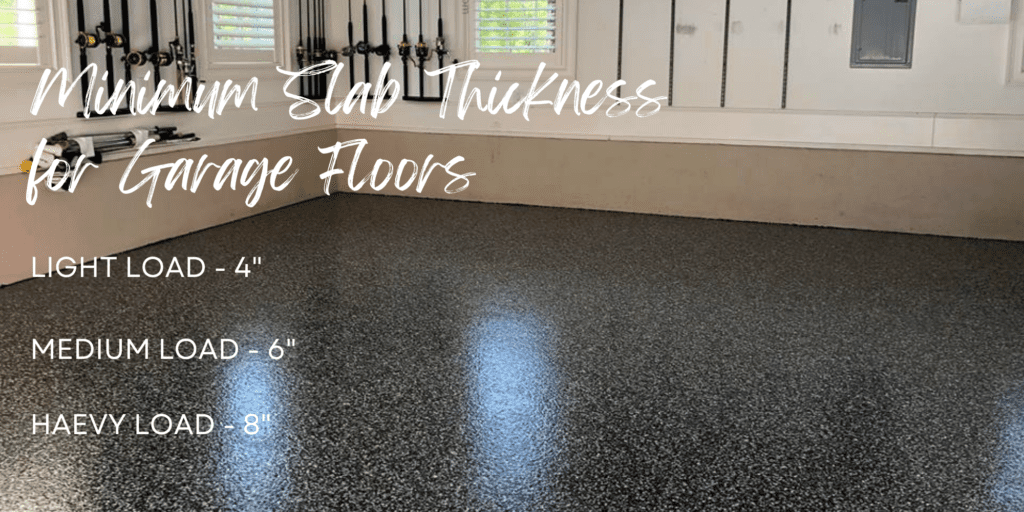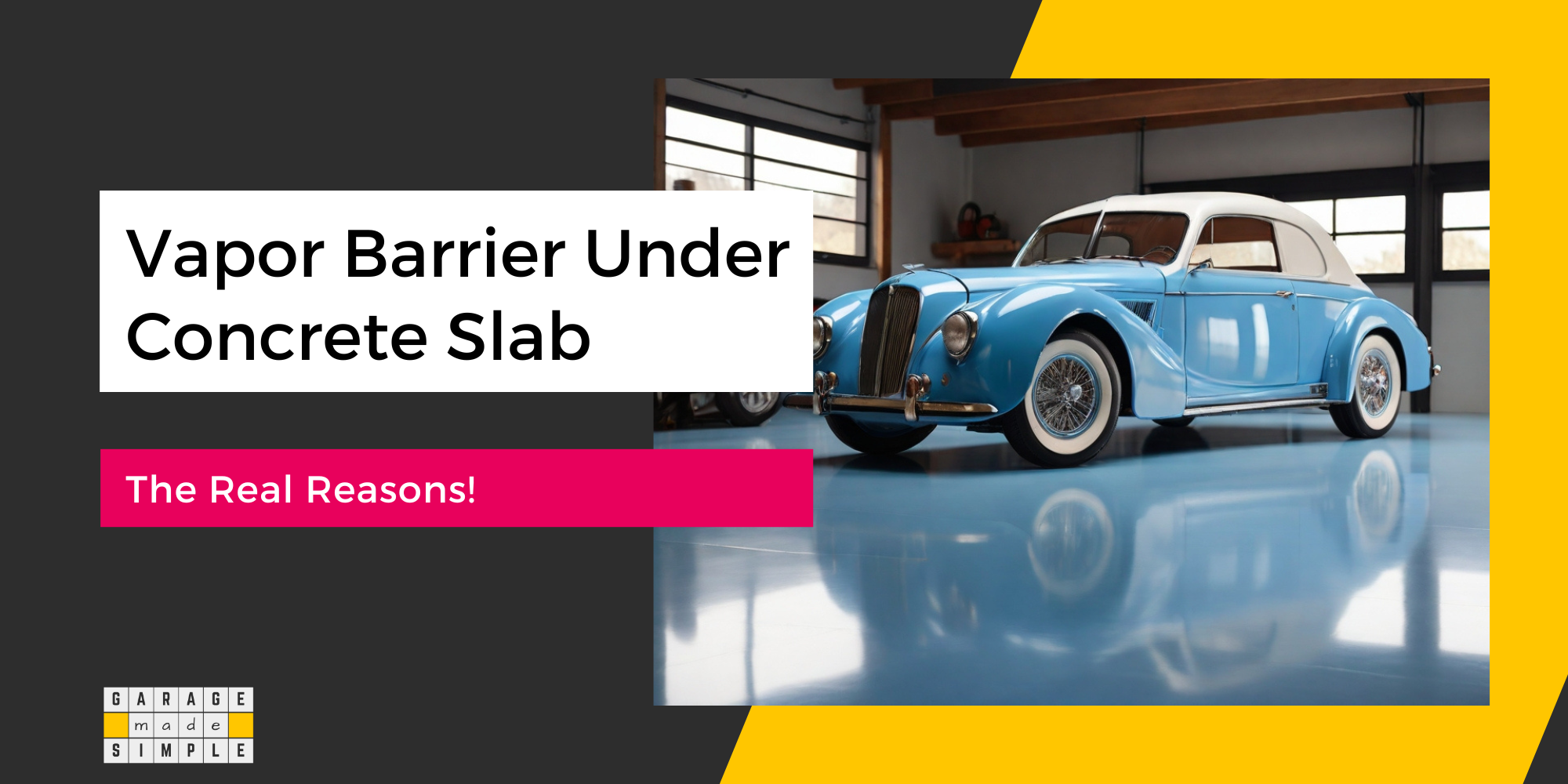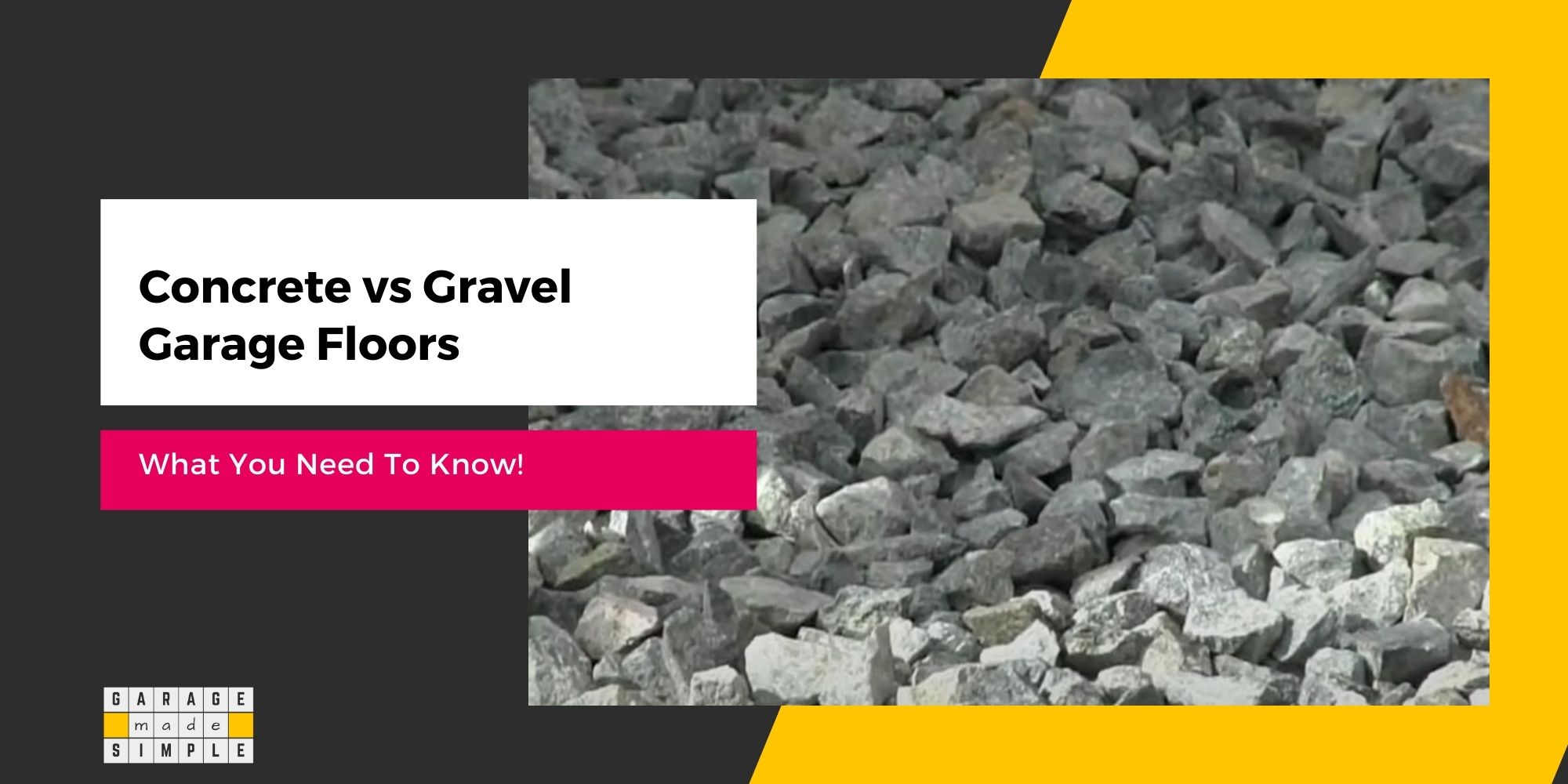Minimum Slab Thickness for Garage & 9 Other Important Factors Determining Strength
garagemadesimple.com is a participant in the Amazon Services LLC Associates Program, an affiliate advertising program designed to provide a means for sites to earn advertising fees by advertising and linking to Amazon.com . The website is also an affiliate of a few other brands.
What Is the Minimum Slab Thickness for Garage Floor?
The minimum slab thickness for garage floor depends primarily on the expected load. The concrete thickness for garage should be at the very least 4″ for light loads, 6″ for medium loads and 8″ for heavy loads.
| Load Type | Minimum Slab Thickness |
|---|---|
| Light Loads | 4 inches |
| Medium Loads | 6 inches |
| Heavy Loads | 8 inches |
NOTE: Section 1907.1 of the 2021 International Building Code (IBC) specifies that the thickness of concrete floor slabs supported directly on the ground shall not be less than 3 1/2″.
However, this is the absolute minimum and applies only when there is no load on the concrete slab at all. Naturally, this is not applicable when it comes to minimum slab thickness for garage floors, as they must be load bearing.

What are Typical Load Levels on a Garage Floor?
The load levels on a residential garage floor are typically classified as:
- Light Loads: 1 – 2 light duty cars, SUVs or trucks.
- Medium Loads: 1 – 2 medium duty SUV’s or trucks.
- Heavy Loads: 1 – 2 heavy duty SUV’s or trucks.
Here are some examples of cars and trucks typically used by US families by weight classification:
Light Duty (GVWR < 8,500 lb)
- Cars: Honda Accord, Toyota Camry, Nissan Altima, Hyundai Sonata, Kia K5
- SUVs: Honda CR-V, Toyota RAV4, Nissan Rogue, Hyundai Tucson, Kia Sportage
- Pickup trucks: Toyota Tacoma, Nissan Frontier, Chevrolet Colorado, GMC Canyon
Medium Duty (GVWR 8,501-10,000 lb)
- SUVs: Chevrolet Traverse, Buick Enclave, GMC Acadia, Ford Explorer, Lincoln Aviator
- Pickup trucks: Ford F-150, Chevrolet Silverado 1500, Ram 1500, GMC Sierra 1500, Toyota Tundra
Heavy Duty (GVWR > 10,000 lb)
- SUVs: Chevrolet Suburban, GMC Yukon, Ford Expedition, Lincoln Navigator
- Pickup trucks: Ford F-250, Chevrolet Silverado 2500HD, Ram 2500, GMC Sierra 2500HD, Ford F-350, Chevrolet Silverado 3500HD, Ram 3500, GMC Sierra 3500HD
Therefore, in reality, while the minimum slab thickness for garage floors can be 4″, the most common slab thickness for garage floors is typically 6″.
The minimum slab thickness for garage floors is both determined and influenced by several factors. Whether you have asked a contractor to pour the garage floor or plan to do it yourself, you must keep in mind 10 important factors.
What Determines the Strength of Concrete?
Minimum slab thickness for garage is an important factor that determines the strength & durability of a concrete garage floor, but it is not the only factor.
Many other factors determine the strength & durability of a concrete “slab on grade”. The important ones are:
- Soil Support System (Base)
- Vapor Barrier (Between Base & Concrete)
- Concrete Strength (psi)
- Concrete Admixtures
- Reinforcement of Concrete
- Compaction of Concrete
- Control & Expansion Joints
- Concrete Curing Conditions
- Garage Slab Loading
1. What Is the Best Base to Use under a Concrete Slab?
Most concrete garage floors are “slab on grade”. A slab on grade rests on the “soil support system” below it and is therefore self supporting.
The soil support system consists of three layers under:
| Subgrade | This is the existing soil. The soil may have been improved by the addition of fresh soil. The soil layer is compacted. |
| Sub Base | Sub base is several layers of aggregates on top of the subgrade. The aggregate must be of irregular shape and different sizes. The bigger aggregates go at the bottom and the smaller aggregates stay at the top. The sub base is compacted at each stage. |
| Base | Base consists of layers of gravel and sand over the sub base. This is smoothed out & compacted. |
.The quality of the soil support system will determine the load bearing capacity of the slab on grade. A slab on grade foundation helps to
- Distribute the load evenly over a large area
- Drain ground water quickly
- Prevent localized soil subsidence
The minimum slab thickness for a garage is therefore a function of how well the base has been prepared.
2. Is Vapor Barrier Necessary for Concrete Slab?
The strength & durability of a concrete slab can be seriously compromised by water vapor movement across it. It can result in
- Coating delamination & failures
- Efflorescence & discoloration
- Corrosion of rebars
- Damaged aggregates
- Slab curling at edges
In most climatic zones and soil conditions, the ground below the garage will have moisture. The vapor pressure will push the moisture through the concrete slab. A vapor barrier is a cheap way to block it. But it must be done after base preparation and before pouring the concrete mix. It can not be done later.
If you put it in you have nothing to worry about. If you do not, you may live to regret your decision.
3. What is the Best Concrete for the Garage Floor?
The best concrete for the garage floor is the one which has the correct concrete strength. Table R402.2 of 2021 International Residential Code (IRC) specifies “Minimum Specified Compressive Strength” for garage floor slabs as:
| Weathering Potential | Compressive Strength (PSI) |
| Negligible | 2500 |
| Moderate | 3000 |
| Severe | 3500 |
One of the best concrete mixing ratios for a slab is 1 : 3 : 3 (cement : sand : stone), this will produce approximately a 3000 psi concrete mix.
EVERYTHING ABOUT CONCRETE
The water cement ratio is critical when it comes to the strength of the concrete slab. Too much water improves workability but reduces strength.
The ideal water cement ratio is 0.5. This translates to 5.6 gallons of water for every cement bag (94 lbs).
I have covered the various factors associated with the concrete mix in my earlier post The Best Concrete Mix For Garage Floor (6 Important Factors!). Do check it out if you are interested in getting more details.
4. Do Admixtures Affect Strength of Concrete?
Concrete admixtures are chemicals or ingredients that are added to the concrete mix during the mixing process in order to give special properties to the concrete mix. The property may be related to workability of the mix during placement or of the concrete slab after curing.
Concrete admixtures do not increase the concrete strength per se, but they increase the rate of concrete strength development.
Concrete admixtures can help reduce the water cement ratio (by 5-10%) without compromising plasticity or workability of the concrete mix. The concrete mix retains its slump in spite of a lower water-cement ratio.
Admixtures have increased both compressive strength and durability of concrete through their water/cement (w/c) reduction, hydrophobic effect, pore reduction/blocking, increased density etc.
The International Journal of Engineering and Science
The result is you can get a higher strength concrete that is also pliable and workable.
5. How Do You Reinforce Concrete?
Concrete slabs have very high compressive strength but relatively poor tensile strength. However, it is possible to increase the tensile strength by reinforcing the concrete slab with rebars, wire meshes or fibers.
Reinforcement
provides all the tensile strength where concrete is in tension, as in beams and slabs; it supplements the compressive strength of concrete in columns and walls; and it provides extra shear strength over and above that of concrete in beams.
American Concrete Institute
The most common way of reinforcing concrete slabs is by embedding deformed steel bars (aka rebars).
However, rebars can not and should not be used if the concrete slab thickness is 4”. To find out why, read my earlier blog post Is Rebar For Garage Slab Important? (What You Need To Know!). You can reinforce a 4” thick concrete garage floor by using wire mesh or fibers.
Rebars can be and should be used for concrete garage floors that are 6” – 8” thick. Rebars will increase the strength & durability of the concrete significantly.
Just like vapor barrier, it must be incorporated after base preparation and before pouring the concrete mix. It can not be done later.
6. What Is the Compaction of Concrete Slab?
Compaction of concrete slab is the process of removing air voids and packing the concrete particles together to increase the density of the slab. This is typically done using vibration, but it can also be done manually using tamping tools.
Proper concrete compaction is essential for a strong & durable garage floor. Air voids in concrete make it weak and susceptible to cracking. Compaction removes the air voids and creates a more solid and dense slab.
Compaction also improves the bond between the concrete and any reinforcement, such as steel rebar or steel wire mesh.
Concrete compaction results in:
- Increased strength and durability
- Improved bond between the concrete and reinforcement
- Reduced permeability to water and other liquids
- Reduced risk of cracking and other damage
- Smoother surface finish
- Higher abrasion resistance
7. Why Do Concrete Slabs Need Control Joints?
Simply put, concrete slabs need control joints to induce the shrinkage cracks to form within the control joints. The control joints prevent the concrete slab from cracking all over, randomly.
In warm climates, control joints are cut with grooving tools, while the concrete is still wet. In cool climates, control joints can be cut with saws after the concrete has hardened somewhat.
Control joints should be no farther apart than 2 – 3 times (in feet) in relation with the concrete slab thickness (in inches).
| Minimum Slab Thickness for Garage (in inches) | Recommended Gap between Expansion Joints (in feet) |
| 4” | 8’ – 12’ |
| 6” | 12’ – 18’ |
| 8” | 16’ – 24’ |
On the other hand expansion joints are required whenever a concrete slab meets a column, wall, or any other structure that will prevent its expansion & contraction with temperature changes. The gap between the garage floor and the driveway is an essential expansion joint.
8. How Does Curing Affect the Strength of Concrete?
When concrete is poured, it is a pliable mixture, much like pottery clay. It has no shape or structural strength. Once fully and correctly cured, concrete becomes rock solid with immense strength & durability.
The concrete curing process is typically
| Time After Pour | Status |
| 1 – 2 days | Forms can be removed. Light foot traffic is OK. |
| 7 days | Partial curing. Vehicular & equipment traffic is OK. |
| 28 days | Full curing. |
The curing process promotes the formation of a crystalline matrix within the concrete mix. The crystals form due to a reaction between water and cement known as hydration. Curing helps by
- Retaining moisture as concrete gains strength
- Delaying shrinkage till concrete can resist shrinkage cracks
- Giving concrete strength, durability, water tightness & wear resistance
The rate of water evaporation from the freshly poured concrete slab determines the ultimate strength developed. The rate of water evaporation depends on
- Water cement ratio
- Concrete mix & ambient temperature
- Local humidity level
9. What Will You Store in the Garage?
The slab strength requirement depends on the weight of the items that you intend to keep on the garage floor.
Most residential garages are used not only to park vehicles but also as storage space, workshop, etc. However, the main difference in the load capacity requirement comes from the weight of vehicles.
Following is a quick guideline on minimum slab thickness for a garage based on vehicle weight:
| Vehicle Type | Number of Vehicles | Weight (lbs each) |
Minimum Slab Thickness | Reinforcement |
|---|---|---|---|---|
| Light Vehicles | 2 | Less than 8,500 | 4 inches | Wire mesh or fiber reinforcement |
| Medium Vehicles | 2 | 8,500-10,000 | 6 inches | Rebar reinforcement |
| Heavy Vehicles | 2 | More than 10,000 | 8 inches | Rebar reinforcement |
Conclusion
To understand the minimum slab thickness for your garage you must keep in mind the 10 important factors explained above.
Use the following as a rough guideline:
- Light Loads – 4” thick with wire mesh or fiber reinforcement
- Medium Loads – 6” thick with steel rebar reinforcement
- Heavy Loads – 8” thick with steel rebar reinforcement
Thank you very much for reading the post. I do hope you found it informative and useful.






